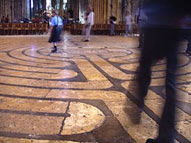Closer to Home
March 29, 2013 / Walking the Labyrinth
I’m not much of a Christian at all, but it is Holy Week, that fraught week between Palm Sunday and Easter, and there are various marvels encoded in churchly behavior to be considered once again. Palm fronds from hot places are brought into cold churches and waved about. At another time this week, in a dimly-lit church people may carefully rinse each other’s bare feet in warm water, and dry them gently with soft cloths. At a night service, all the lights in the church are turned off one by one, and the people leave in silent, perfect darkness. All the pretty objects that can be taken away in the church might be taken away. People may eat morsels of bread dipped in salt water. It’s quite shocking; it’s supposed to be, and all of these rituals may nudge one along to shock and wonder.
The church I have been going to for a very short time has borrowed a Labyrinth, I guess from another church. It’s a big canvas circle, with blue “walls” painted on it in the pattern of an elegant maze, although there is only one path to its center, and that is obvious, though serpentine. It was laid down and firmly affixed in the center of the church, and it has been available for walking all week long.
It seems that labyrinths have a long history. Of course there was the fearsome Minotaur of Greek mythology, who lurked in one. There appear to have been labyrinths in various cultures, from Native America to Nepal and from South America to Java and Australia, as early as 2500 B. C., but their uses are obscure. They are present in churches of ancient Rome. In medieval Gothic churches labyrinths were sometimes laid right into the design of the floor, as at Chartres (see below) and Reims. Perhaps the faithful made a symbolic pilgrimage to Jerusalem by walking these labyrinths, but this is not certain. Labyrinths can be made of cloth with a painted design, as ours is, or of tile, or even rocks or plants. People these days have many labyrinths to choose from, and TheLabyrinthSociety.org can tell you all about them.
I went to visit our Labyrinth this morning, and to walk it. It is unicursal, meaning that it has a single, non-branching path to its center (another nice word to add to your vocabulary). This means that when I entered it, and made my way to its center, I was eventually going to leave the same way.
I was not sure what to expect of my walk. What was I seeking, in its center? I decided that somehow the form was symbolic of my life’s path, the end of which is in sight, at my age. The center seemed to me to be the place of fullest flower, the realising of all I might make of this great gift of life. So I entered, at birth, and, walking, sought the elusive center.
Approaching, turning away, re-turning and coming close to previous turning-places, then striding easily and confidently along the long clear paths with no knotty places, but then having to be so attentive on all the short paths with much turning and about-facing. At the center, my center, the Fullness. Then the return, feeling so new and yet deeply familiar, contemplating where I have been, how the later places approach the earlier ones so closely, and then the emptying-out, the final departure.
The idea of going out at the same place as you went in was intriguing. Plato made one of his Dialogue characters say, of an argument, “Then it seemed like falling into a labyrinth: we thought we were at the finish, but our way bent round and we found ourselves as it were back at the beginning, and just as far from that which we were seeing at first.”
Not to mention Edward Fitzgerald’s thought in the Rubaiyat of Omar Khayyam:
Myself when young did eagerly frequent
Doctor and Saint, and heard great argument
About it and about: but evermore
Came out by the same door where in I went.
For each pilgrim, the labyrinth, and the life path, is a summons to invest the journey with one’s own meaning, obligation, resolution, celebration, and enthusiasm. Those virtues remain constant though they may ebb or flow at different turnings. You come in with them, you leave with them. Relish them, nurture them at the Center.
Comments
-
Jeremy 09:08pm, 05/12/2013
I love your whole outlook on the world. You are a true ray of light, Hilary! I’m so blessed to know you.